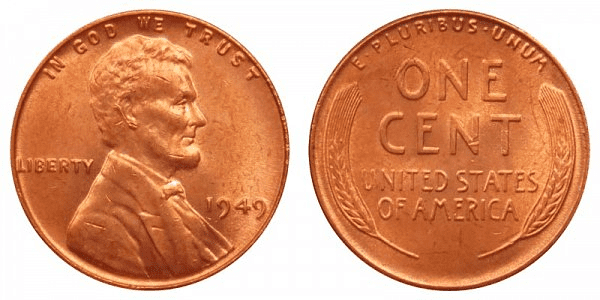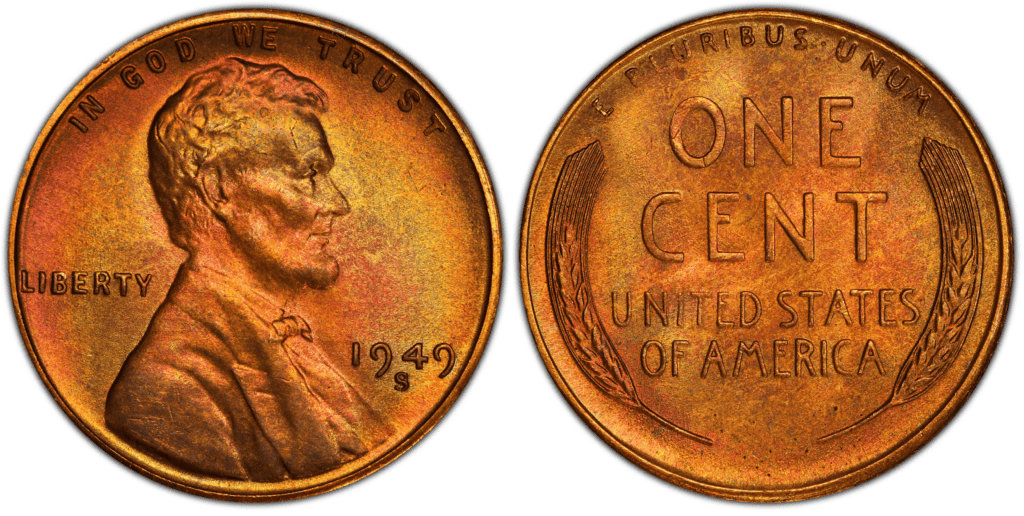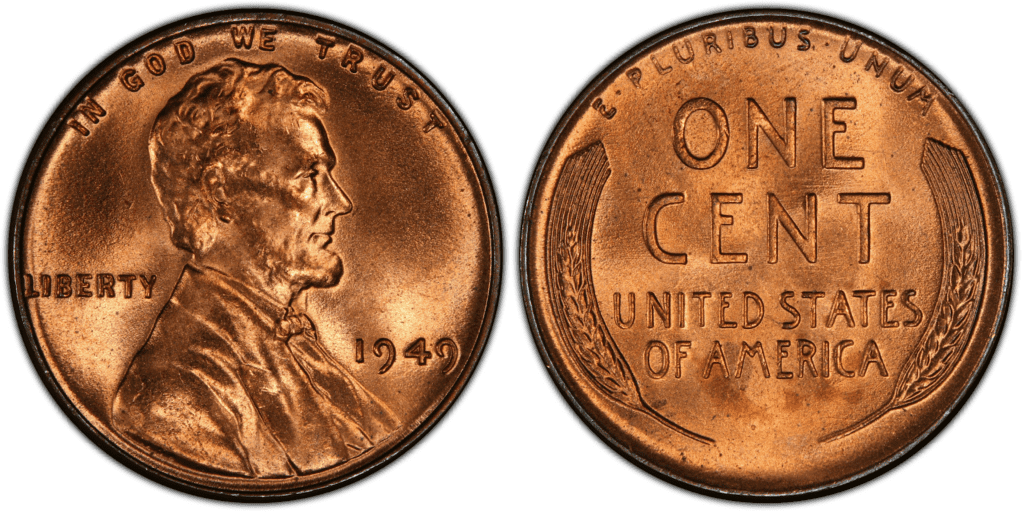What Is the 1949 Lincoln Wheat Penny Made Of?
The smallest unit of currency in the US is the penny, and it is also perhaps the most popular US coin. First struck in 1909, the Lincoln penny is among the longest-running coins minted.
The Lincoln Wheat Cent family, which features Abraham Lincoln’s likeness on the front, includes the 1949 penny. If you inspect the coin, you can see two wheat ears on its rear side. The one-cent coin weighs 3.11 grams and has a diameter of 19 millimeters. It is made of 95% copper and 5% tin and zinc.
Three facilities across the United States—Philadelphia, Denver, and San Francisco—produced these particular coins. In addition, because they are mostly made of copper with a thin zinc and tin coating on top for coloring, each piece costs only one cent to produce.
Victor D. Brenner designed the coin’s reverse and obverse sides. Originally, the reverse features wheat images; thus, it was called wheat pennies until the reverse design was changed into the Lincoln Memorial in 1959.
Today, the reverse bears the design made by Lyndall Bass beginning in 2010, which depicts the Union shield. The term penny was derived from the name of coins struck in England.

The 1949 Lincoln Wheat Penny obverse shows the most minutely detailed and razor-sharp representation of Abraham Lincoln’s likeness. The date numerals are prominent in serif patterns, while the obverse legend writing is thin and clear.
The president is facing right, wearing his distinctive bowtie. IN GOD WE TRUST is written at the top of the image, followed by the word “LIBERTY” close to the rim on the left and the minting year 1949 on the right. If present, you’ll also find the mint mark on the obverse side.
On the reverse side, you find the two stalks of wheat, one on the left and one on the right. Inscriptions include the following:
- E Pluribus Unum
- One Cent
- United States of America
1949 Lincoln Wheat Penny Varieties
The Lincoln Wheat Penny series, which was coined to honor Abraham Lincoln’s birthday, includes the 1949 wheat penny. They were initially issued in 1909 and were still in circulation in 1958.
During this time, the United States and the rest of the globe were still recuperating from the damage caused by World War II in 1949. There was a deliberate effort to recover from the US economic collapse and to reconstruct the nation.
As such, the US mint was forced to hunt for an alternative because of the increased demand for copper during the war. To save copper, the US Mint began using steel blanks in 1943. They used the pennies created from this alloy in special sets dubbed “special mint sets,” which contained proof-like coins instead of for general use.
As a result, the 1949 Wheat Penny was minted. The size of the coin had to be decreased due to the rise in copper prices, which made it possible to produce pennies mostly out of steel. Therefore, the new penny had nearly identical dimensions but weighed 2 grams less than its predecessor.
The proximity of the 1949 Lincoln Wheat Penny to the end of World War II in August 1945 significantly impacted its characteristics. The major social, political, and economic developments at the time permanently altered the process of minting US coins. The coin also wasn’t made of silver like most of its Wheat Series predecessors from before the war. Additionally, the copper content of post-war Lincoln cents is lower.
There were no proof pennies made in 1949.
Mintage Of The 1949 Wheat Penny
| 1949 Wheat Penny | Mint Location | Pieces Minted |
| 1949 (no mintmark) | Philadelphia | 217,775,000 |
| 1949-D | Denver | 153,132,500 |
| 1949-S | San Francisco | 64,290,000 |
Here’s a deeper look at the 1949 wheat penny varieties:
1949 D Lincoln Wheat Penny
Edge: Smooth
Mint Mark: D
Place of minting: Denver
Year of minting: 1949
Face Value: $0.01 (one cent)
Price: $8 to $26 (or more)
Quantity produced: 153,132,500
Designer: Victor D. Brenner
Composition: 95% copper and 5% tin and zinc
Mass: 3.11 grams
Diameter: 19 mm

photo source: PCGS
Among the issued coins in the 1940s, the 1946-D variety was the lowest mintage and hardest to find in circulated condition. For uncirculated condition, the 1946 Walking Liberty fifty-cent piece is the second most common versus the 1943 Philadelphia-minted Walking Liberty half dollar being more common.
1949 P Lincoln Wheat Penny
Edge: Smooth
Mint Mark: no mintmark
Place of minting: Philadelphia
Year of minting: 1949
Face Value: $0.01 (one cent)
Price: $11 to $35 (or more)
Quantity produced: 217,775,000
Designer: Victor D. Brenner
Composition: 95% copper and 5% tin and zinc
Mass: 3.11 grams
Diameter: 19 mm

photo source: PCGS
The 1949 P wheat penny was struck in the Philadelphia Mint. There were about 217 million of these pennies issued in 1949. Uncirculated 1949-P pennies may be around $11 to $35
1949 S Lincoln Wheat Penny
Edge: Smooth
Mint Mark: S
Place of minting: San Francisco
Year of minting: 1949
Face Value: $0.01 (one cent)
Price: $11 to $16 (or more)
Quantity produced: 64,290,000
Designer: Victor D. Brenner
Composition: 95% copper and 5% tin and zinc
Mass: 3.11 grams
Diameter: 19 mm

photo source: PCGS
The San Francisco Mint produced more than 64 million 1949-S 1-cent coins. The price is lower than other varieties.
List Of 1949 Lincoln Wheat Penny Errors
A coin’s numismatic value increases due to rare features and errors. Some more uncommon 1949 Lincoln Wheat Pennies have a doubled die, a repunched mintmark, or an enlarged or double-struck mintmark.
- A doubled die – The coin’s obverse or reverse both feature doublings.
- A repunched mintmark – There is a small indent where the mintmark was stamped into this die.
- An enlarged or double-struck mintmark – The mintmark on this coin is large, indicating that it was possibly struck twice by the dies.
How Much Is The 1949 Lincoln Wheat Penny Worth Today?
A 1949 wheat penny’s value is mostly influenced by its condition and mintmark. This penny is less expensive than its silver counterparts because it is made of 95% copper and 5% tin and zinc, yet it only has a face value of one cent. In addition, the 1949 cent has a $0.0252 mint value.
Looking at the face value and mint value, you might think it’s not worth collecting them. However, it definitely has a higher numismatic value, for sure. The standard price for a circulated 1949 wheat penny is about $0.02 to $0.04.
The prices of the uncirculated coins likewise varied greatly. As an example, the MS-63RB grade costs about $1. The uncirculated MS-63 RB then costs roughly $3. You can earn up to $4 if you have the MS-65RB quality wheat penny.
To really understand how much the 1946 wheat penny can be, here’s a table for you to compare its prices depending on its variety, condition, and grade:
| Coin | Condition | Grade | Mintage | Value |
| 1949 D Lincoln penny | Circulated/mint | Not graded | 153,132,500 | $0.02 to $0.40 |
| 1949 D Lincoln penny | Uncirculated/mint | MS-65 | 153,132,500 | $8 to $26 |
| 1949 D Lincoln penny | Uncirculated/mint | MS-66 | 153,132,500 | $45 to $165 |
| 1949 D Lincoln penny | Uncirculated/mint | MS-67 | 153,132,500 | $144 to $1,020 |
| 1949 P Lincoln penny | Circulated/mint | Not graded | 217,775,000 | $0.02 to $0.40
|
| 1949 P Lincoln penny | Uncirculated/mint | MS-65 | 217,775,000 | $11 to $35 |
| 1949 P Lincoln penny | Uncirculated/mint | MS-66 | 217,775,000 | $41 to $168 |
| 1949 P Lincoln penny | Uncirculated/mint | MS-67 | 217,775,000 | $504 to $2,160 |
| 1949 S Lincoln penny | Circulated/mint | Not graded | 64,290,000 | $0.02 to $0.40 |
| 1949 S Lincoln penny | Uncirculated/mint | MS-65 | 64,290,000 | $11 to $16 |
| 1949 S Lincoln penny | Uncirculated/mint | MS-66 | 64,290,000 | $25 to $118 |
| 1949 S Lincoln penny | Uncirculated/mint | MS-67 | 64,290,000 | $100 to $144 |
As you can see, the 1949 wheat penny can be valuable if it is in the right condition. However, to really get the full idea of how much this penny can be worth, check out these auction records:
- $12,075 – a 1949 1C, RD (Regular Strike) coin with a grade of MS67 sold in August 2006 by Bowers & Merena
- $5,760 – 1949-D 1C, RD (Regular Strike) coin with a grade of MS67+RD sold in January 2019 by Heritage Auctions
- $3,525 – a 1949-S 1C, RD (Regular Strike) coin with a grade of MS67+RD sold in December 2015 by Legend Rare Coin Auctions
How Does The Grading System Work?
The Sheldon Scale is used by numismatists to provide a numerical value to coins. The Sheldon Scale goes from poor (P-1) to perfect mint state (P-1) (MS-70). Coins were originally evaluated using words to reflect their condition (Good, Fair, Excellent, Etc.). Unfortunately, coin collectors and dealers had different ideas about what each of these terms represent.
Professional numismatists joined together in the 1970s and established CoinGrading standards. These numismatists now assign grades at key places on the seventy-point scale, using the most regularly utilized numeric points in conjunction with the original adjective grade. The following are the most common coin grades:
-
-
- (P-1) Poor – Indistinguishable and probably damaged; if used, must have a date and mintmark; otherwise, rather battered.
- (FR-2) Fair – Nearly smooth, but without the damage that a coin graded Poor often possesses. The coin must have enough detail to be identified.
- (G-4) Fair – Inscriptions have merged into the rims in some areas, and important elements have been mostly erased.
- (VG-8) Very Good- A little weathered, but all of the primary design elements are visible, albeit faintly. There is little if any, central detail left.
- (F-12) Good – The item is very worn, yet the wear is even, and the overall design details stand out clearly. Rims are almost completely isolated from the field.
- (VF-20) Very Fine – Moderately weathered, with some finer features still visible. The motto or all letters of LIBERTY are readable. Both sides of the coin have entire rims that are separated from the field.
- (EF-40) Extremely Fine – Gently used; all gadgets are visible, and the most important ones are bold. The finer details are bold and clear, however, light wear may be seen.
- (AU-50) Uncirculated – Slight evidence of wear on the coin’s design’s high points; may have contact marks; eye appeal should be adequate.
- (AU-58) Uncirculated Choice – Slight traces of wear, no severe contact marks, almost full mint shine, and great eye appeal.
- (MS-60) Mint State Basal – Strictly uncirculated; no indication of wear on the coin’s highest points, but an unsightly coin with reduced luster, visible contact marks, hairlines, and other flaws.
- (MS-63) Mint State Acceptable – Uncirculated, but with contact scratches and nicks, little reduced shine, but otherwise appealing appearance. The strike is weak to average.
- (MS-65) Mint State Choice – Uncirculated with great mint shine, very little contact blemishes, and exceptional eye appeal. The strike is unusually severe.
- (MS-68) Mint State Premium Quality – Uncirculated with superb luster, no obvious contact marks to the naked eye, and exceptional eye appeal. The strike is quick and appealing.
- (MS-69) Almost Perfect Mint State – Uncirculated with perfect brilliance, a sharp and appealing strike, and extremely good eye appeal. A near-perfect coin with minor imperfections in the planchet, strike, and contact markings (seen only under 8x magnification).
- (MS-70) Mint State Perfect – Under 8x magnification, there are no tiny imperfections discernible; the strike is crisp, and the coin is perfectly centered on a beautiful planchet. Rarely seen on a coin, this coin is bright and whole, with original luster and exceptional eye appeal.
-
Where To Buy Or Sell 1949 Lincoln Wheat Penny?
Visit the web for the most practical way to buy or sell 1949 Lincoln Wheat Pennies. Most sellers submit offers on eBay, Etsy, Amazon, and numerous other online retailers. If you’re lucky, you can find sellers offering their one-of-a-kind coins for sale. Just know they can cost a lot if they’re in good quality and condition.
However, if you would rather shop in person, you can sell or give your valuable coins, such as the 1949 Lincoln Wheat Pennies, to pawnshops or antique shops. Your preferred locations include coin stores and auction houses.
If you need guidance on how and where to buy or sell your 1949 Lincoln Wheat Pennies, experts from PCGS and NGC can also serve as your advisers.
FAQs
Where is the mint mark on a 1949 wheat penny?
You can find the “D” mint mark under 1949 in the 1949-D Lincoln Wheat Penny minted in Denver. In the same way, you can find the “S” mintmark under the year 1949 in the 1949-S Lincoln Wheat Penny minted in San Francisco. You can find no mint mark in the 1949 Lincoln Wheat Penny minted in Philadelphia.
Is the 1949 wheat penny worth anything?
An “Extremely Fine” wheat penny may cost $4 or more, although it can reach as high as $30 for an “Uncirculated” wheat penny with no traces of wear and tear.
What Would A 1949 Lincoln Penny In Good Condition Be Worth?
A penny in “Good” condition is worth, at most, $0.50.
How Much Is A 1949 Lincoln Penny That Has Just Been Lightly Cleaned Worth?
A 1949 Lincoln Penny will probably lose roughly 50% of its value with light cleaning.
[H3] What Is The Value Of An Almost Uncirculated (AU) 1949 Lincoln Penny?
A coin with an “Almost Uncirculated” (AU) grading may cost $10 or more. An “Uncirculated” 1949 Lincoln Penny could be valued at over $100.
What Is The Value Of A Bent And Then Flattened 1949 Lincoln Penny?
A coin’s worth will not increase if bent first, then flattened. Coins with this type of damage are sold for the value of the metal they contain, such as copper and nickel, depending on their composition.


